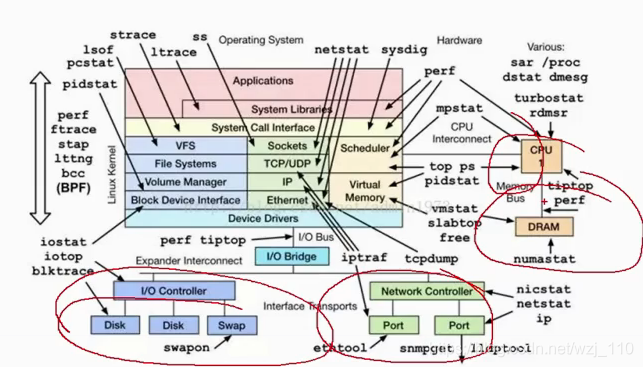本文共 2977 字,大约阅读时间需要 9 分钟。
一 监控的重要性和监控平台
把握:了解当前服务器的状态,理论上监控所有可以监控的事情!
(1)
特点:流量与性能监测为主,绘制表格!
展示平台:B/S
收集数据:SNMP Simple Network Management Protocol(监控最基本的协议)
RRD tool -->通过命令行来进行绘图!
(2)
特点:服务与性能监测为主
展示平台:B/S
收集数据:C/S(脚本)
(3)(主流)
特点:新型全功能监控软件
展示平台:B/S
收集数据:C/S
早期:手动脚本(awk、sed)脚本来进行,问题:脚本效率、很麻烦、多台电脑的情景!
可以监控的信息如下

二 Zabbix
(1)概念
zabbix 是一个基于WEB界面的提供分布式系统监视以及网络监视功能的企业级的开源解决方案 ( 基于 GPL V2 )
构成:zabbix由 2 部分构成zabbix server与可选组件zabbix agent
(2)zabbix 安装完成后会产生 5 个程序说明
zabbix_agentd、zabbix_get、zabbix_proxy、zabbix_sender、zabbix_server,zabbix_java_gateway是可选,这个需要另外安装
(1)zabbix_agentd:客户端守护进程(运行在客户端),此进程收集客户端数据;例如 cpu负载、内存、硬盘使用情况等
关键:安装在客户端,被收集的服务器上,启动的是TCP/10050端口
(2)zabbix_get:zabbix 工具,单独使用的命令,通常用于排错(测试)!
特点:向被监控的主机收集数据
(3)zabbix_sender:zabbix工具,用于发送数据给 server 或者 proxy ,在脚本完成之后使用 sender 主动将数据提交
特点:主动提交
(4)zabbix_server:zabbix 服务端守护进程(运行在服务器端),所有的数据都是被提交或主动提交到zabbix_server端
(5)zabbix_proxy:zabbix代理守护进程。功能类似server,只是一个中转站,需要把收集到的数据提交/被提交到server里
说明:分布式的核心
(6)zabbix_java_gateway:zabbix2.0之后引入的一个功能,顾名思义:Java网关,类似agentd,但是只用于Java方面。
特别注意:它只能主动去获取数据,而不能被动获取数据,它的数据最终会给到server或者proxy!
特点:获取JVM的信息!
补充:根据需要安装,对应的守护进程不一样,但至少有两个!
(2)zabbix原理

GUI:图形化用户接口!
zabbix-database:一般是mysql数据库!
核心:zabbix-server得到zabbix-agent所采集的数据,然后把数据插入到mysql数据库,PHP语言通过php-mysql调取mysql的数据分析,最后展示给用户看!
核心:数据库!
(4)收集数据的方式
agent:操作系统级别,最稳定!
智能管理接口(IPMI):智能硬件
交换机、打印机,通过传统ICMP/SNMP
(3)构建Zabbix的监控
核心:防火墙和Selinux必须关闭!
注意点:zabbix包权限的问题,否则出现403的问题!
细节:修改主机名和本地解析!
1)服务器端(Server)
yum install zabbix-server-mysql zabbix-web-mysql -y # 安装zabbix(代理可以暂时不安装) yum install mariadb-server -y # 安装数据库 systemctl start mariadb systemctl enable mariadb # 习惯服务做成开机自启! mysql_secure_installation # mariadb的初始化必须在mariadb服务启动的条件下进行!
细节:mariadb必须先开启服务再修改密码(默认是空)
对数据库的配置
-- (1)创建数据库 -->默认字符集,排序方式!create database zabbix character set utf8 collate utf8_bin;-- (2)授权grant all privileges on zabbix.* to zabbix@localhost identified by 'redhat';-- 最好刷新权限表!
说明:本次实验mariadb数据库和zabbix-server在同一台物理机(虚拟机中),真实场景单独放!
下一步:导入zabbix的官方的数据库模版
zcat /usr/share/doc/zabbix-server-mysql-4.0.5/create.sql.gz | mysql -uzabbix -p zabbix# 说明:由于物理性能的问题,可能时间会比较长!
zact:查看压缩文档的内容
说明:登陆mariadb后,进入zabbix的数据库,进行相关操作!
注意:千万不要忘记测试
-- mysql -predhat zabbix show tables -- 进行查看
下一步:修改zabbix的配置文件
原因:有些参数是默认的,跟实际情况不匹配!
vim /etc/zabbix/zabbix_server.conf# DBHost=localhost# DBName=zabbix# DBUser=zabbix# DBPassword=redhatsystemctl start zabbix-server # 启动服务systemctl enable zabbix-server
说明:由于刚刚授权是localhost本地登陆,所以这里也必须是Localhost,与前面的相匹配!
注意:服务是否开启,最好看下日志和端口!10051端口是否开启
vim /var/log/zabbix/zabbix_server.log
配置:zabbix在httpd的模版,安装zabbix-server时安装的!
vim /etc/httpd/conf.d/zabbix.confphp_value date.timezone Asia/Shanghai # 修改时区systemctl start httpd systemctl restart httpdsystemctl enable httpd # 说明:apach似乎是zabbix-server会默认安装的# httpd-tools-2.4.6-45.el7.x86_64
展示首页

# 说明:配置文件的网页目录 /usr/share/zabbix/# 里面的是php的页面!
默认访问不友好,修改Apach的主配置文件
vim /etc/httpd/conf/httpd.conf DocumentRoot "/usr/share/zabbix" # 120行左右systemctl reload httpd

说明:初始化用户名是Admin,用户密码是zabbix!
界面的相关说明

转载地址:http://vpzwz.baihongyu.com/